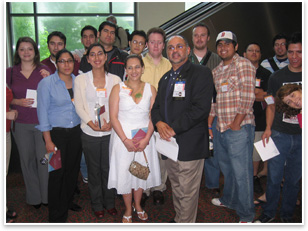
Minority Architecture Students Shadow AIA Architects at Convention How do you . . . mentor minority architecture students?
The students were divided into 13 groups to shadow 16 AIA architects during the convention. The students joined their mentors at the general session, the AIA Whitney M. Young Jr. Forum, the Minority Fellows Reception, and on the expo floor. Two instructors from the college also participated. The mentors also enlisted colleagues to further the one-on-one “shadow” experience with the students. “Shadow an Architect” a success We wanted the students to be eye-to-eye with architects who looked like them, and to see that there is a possibility of pursuing architecture as a career “I think it was a success because of the participation of everyone involved,” enthuses Padilla. “There was a great response from our Board members and the Diversity Committee to be mentors. I think it’s important that the AIA has an outreach program in the host cities to give back and engage future architects. The biggest thing that we wanted to have happen is have the students, being from an inner-city school and minority community, be eye-to-eye with architects who looked like them, and to see that there is a possibility of pursuing architecture as a career. I hope it will turn into a legacy program, done at every convention site.” Padilla explains that discussions were held the last few years within the Diversity Committee on ways the AIA could engage local, under-represented minority students at the national conventions. “For students, it’s a need to have that one opportunity to visit one-on-one with an architect at a casual but major AIA experience,” he says. Kwan, who coordinated the Diversity Committee participation, says that last year the Diversity Committee held a strategic meeting in Chicago after the convention. “We wondered: ‘Why did we not engage students in Los Angeles, one of the most diverse cities?’ So we decided to start a pilot program in San Antonio. The YAF put out a call for volunteers, and we matched Board Members with students, and John also recruited board members to help.” A lot of minority students will stay close to home to do their first two years in a junior college program, and then move to a university program Padilla felt it was important that both the older and younger architects engaged the students to advocate a diverse mix of mentors. He also thought targeting the junior college level was significant, and praised Isabella Garcia, instructor at the San Antonio College School of Architecture, for her presentation at the Minority Fellows Reception that called for the need to support junior college programs. Padilla points out: “A lot of minority students will stay close to home to do their first two years in a junior college program, and then move to a university program.” Kwan agrees: “Many students with a disadvantaged background don’t go directly to a four-year school of architecture—they go to a community college, with limited exposure to architecture. I don’t think the current system addresses the junior college route as a feeder of getting people into our profession.” Kwan says the students were “totally blown away” by what they saw and experienced on the expo floor. Padilla points out that cutting-edge computer technology at the expo, such as AutoCAD, was a big hit. Architects to connect locally When the convention goes to a city that has many minority students, it is nice to have the architects connect locally “I think that when the convention goes to a city that has many minority students, it is nice to have the architects connect locally,” adds Kwan. “I encourage knowledge communities to reach out because a lot of people don’t know what architects do. This is a great way for the AIA to promote what we do.” The Diversity Committee plans to work with YAF, the Board, and the Boston Society of Architects to match mentors with local students for next year’s convention in Boston. Kwan says the Diversity Committee plans to work with the YAF to add charrette design to the program. |
||
Copyright 2007 The American Institute of Architects. All rights reserved. Home Page |
||
home
news headlines
practice
business
design
recent related
› Convention Closes with Presidential Medals and Heartfelt Thanks
› The Educators
› Young African American Women Architects Sharpen Ties to Their Communities

 Summary:
Summary: